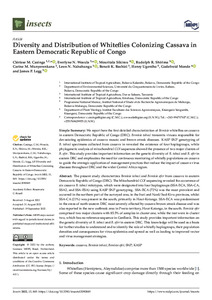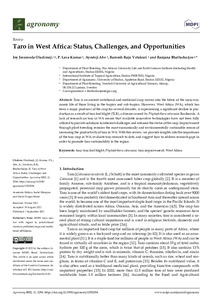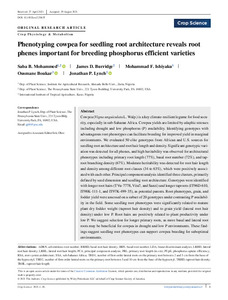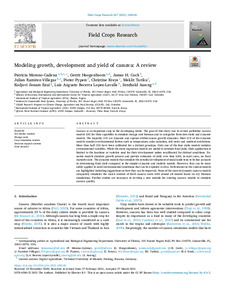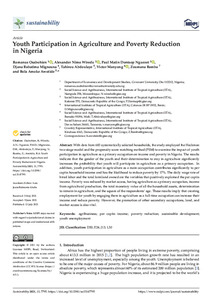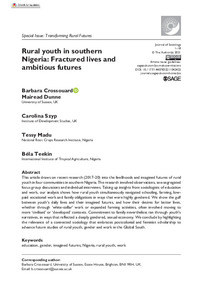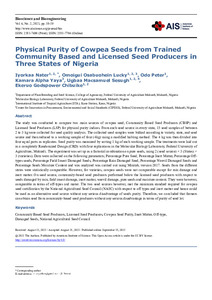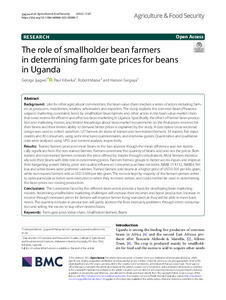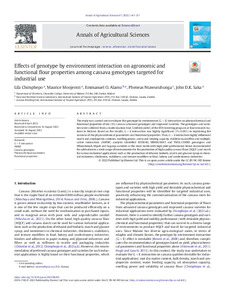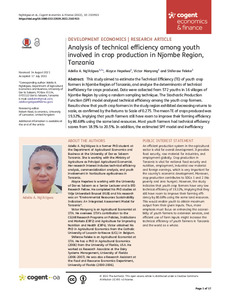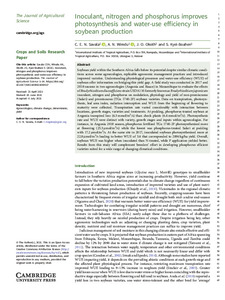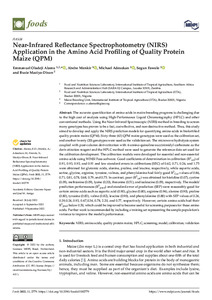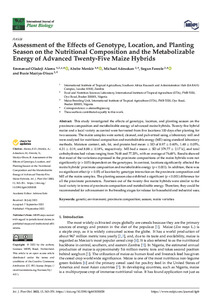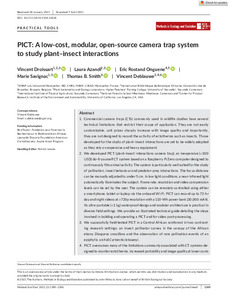Welcome to the International Institute of Tropical Agriculture Research Repository
Journal and Journal Articles: Recent submissions
Now showing items 521-540 of 5266
-
Long-term evidence for ecological intensification as a pathway to sustainable agriculture
(2022-09)Ecological intensification (EI) could help return agriculture into a ‘safe operating space’ for humanity. Using a novel application of meta-analysis to data from 30 long-term experiments from Europe and Africa (comprising 25,565 yield records), we investigated how field-scale EI practices interact with each other, and with N fertilizer and tillage, in their effects on long-term crop yields. Here we confirmed that EI practices (specifically, increasing crop diversity and adding fertility crops and ... -
Diversity and distribution of whiteflies colonizing cassava in eastern Democratic Republic of Congo
(2022)The present study characterizes Bemisia tabaci and Bemisia afer from cassava in eastern Democratic Republic of Congo (DRC). The Mitochondrial COI sequencing revealed the occurrence of six cassava B. tabaci mitotypes, which were designated into four haplogroups (SSA-ECA, SSA-CA, SSA2, and SSA-ESA) using KASP SNP genotyping. SSA-ECA (72%) was the most prevalent and occurred in the northern part of the surveyed area, in the Ituri and Nord/Sud-Kivu provinces, whilst SSA-CA (21%) was present in the ... -
Adaptation strategies to climate change and impacts on household income and food security: evidence from Sahelian region of Niger
(2022-03-01)Sahelian countries, particularly Niger, are more vulnerable to climate change due to the high dependence of most of their populations on rain-fed agriculture and limited capacities to respond to climate variability and change. This paper examines the factors influencing climate change adaptation strategies and the impacts on household income and food security in rural Niger. For this purpose, we collected data from 1783 valid rural households in four main agricultural regions of Niger. The results ... -
Strategizing research and development investments in climate change adaptation for root, tuber and banana crops in the African Great Lakes Region: a spatial prioritisation and targeting framework
(2022-10-22)CONTEXT Given the significance of climate change impacts on farming communities, large investments are made by research and development actors, including farmers themselves, to adapt agricultural systems. A data-driven approach is required to guide these investments and maximize their impact. In the African Great Lakes Region (GLR), root, tuber and banana (RT&B) crops are a vital component of smallholder farming systems, but little is known about strategies to mitigate climate change impacts on ... -
Taro in west Africa: status, challenges, and opportunities
(2022-09-01)Taro is an ancient nutritional and medicinal crop woven into the fabric of the socio-economic life of those living in the tropics and sub-tropics. However, West Africa (WA), which has been a major producer of the crop for several decades, is experiencing a significant decline in production as a result of taro leaf blight (TLB), a disease caused by Phytophthora colocasiae Raciborski. A lack of research on taro in WA means that available innovative technologies have not been fully utilized to provide ... -
Phenotyping cowpea for seedling root architecture reveals root phenes important for breeding phosphorus efficient varieties
(2021)Cowpea (Vigna unguiculata L. Walp.) is a key climate-resilient legume for food security, especially in sub-Saharan Africa. Cowpea yields are limited by edaphic stresses including drought and low phosphorus (P) availability. Identifying genotypes with advantageous root phenotypes can facilitate breeding for improved yield in marginal environments. We evaluated 50 elite genotypes from African and U.S. sources for seedling root architecture and root hair length and density. Significant genotypic ... -
Modeling growth, development and yield of cassava: a review
(2021-06-15)Cassava is an important crop in the developing world. The goal of this study was to review published cassava models (18) for their capability to simulate storage root biomass and to categorize them into static and dynamic models. The majority (14) are dynamic and capture within season growth dynamics. Most (13) of the dynamic models consider environmental factors such as temperature, solar radiation, soil water and nutrient restrictions. More than half (10) have been calibrated for a distinct ... -
Youth participation in agriculture and poverty reduction in Nigeria
(2021)With data from 683 systematically selected households, the study employed the Heckman two-stage model and the propensity score matching method (PSM) to examine the impact of youth participation in agriculture as a primary occupation on income and poverty in Nigeria. The results indicate that the gender of the youth and their determination to stay in agriculture significantly increases the probability that youth will participate in agriculture as a primary occupation. In addition, youth participation ... -
Rural youth in southern Nigeria: fractured lives and ambitious futures
(2021)This article draws on recent research (2017–20) into the livelihoods and imagined futures of rural youth in four communities in southern Nigeria. The research involved observations, sex-segregated focus group discussions and individual interviews. Taking up insights from sociologists of education and work, our analysis shows how rural youth simultaneously navigated schooling, farming, low-paid vocational work and family obligations in ways that were highly gendered. We show the gulf between youth’s ... -
Physical purity of cowpea seeds from trained community based and licensed seed producers in three states of Nigeria
(2021)The study was conducted to compare two main sources of cowpea seed, Community Based Seed Producers (CBSP) and Licensed Seed Producers (LSP) for physical purity indices. From each seed source in every state, 15 seed samples of between 2 to 3 kg were collected for seed quality analysis. The collected seed samples were bulked according to variety, state, and seed source and then reduced to a working sample of four (4kg) using a modified halving method. The 4 kg was then divided into four equal parts ... -
The role of smallholder bean farmers in determining farm gate prices for beans in Uganda
(2022-09-07)Like for other agricultural commodities, the bean value chain involves a series of actors including; farmers as producers, middlemen, retailers, wholesalers and exporters. The study explains the common bean (Phaseolus vulgaris) marketing constraints faced by smallholder bean farmers and other actors in the bean value market chain that need redress for efficient and effective bean marketing in Uganda. Specifically, the effect of farmer bean production and marketing modes, and limited knowledge about ... -
Effects of genotype by environment interaction on agronomic and functional flour properties among cassava genotypes targeted for industrial use
(2022-12)The study was carried out to evaluate the genotype by environment (G × E) interaction on physicochemical and functional properties of ten (10) cassava advanced genotypes and improved varieties. The genotypes and varieties were collected from a multi-location trial (Uniform yield) of the IITA breeding program at four research stations in Malawi. Based on the results, G × E interaction was highly significant (P ≤ 0.001) in explaining the variance of the physicochemical parameters and functional ... -
Analysis of technical efficiency among youth involved in crop production in Njombe Region, Tanzania
(2022-09-02)This study aimed to estimate the Technical Efficiency (TE) of youth crop farmers in Njombe Region of Tanzania, and analyze the determinants of technical inefficiency for crops produced. Data were collected from 572 youths in 16 villages of Njombe Region by using a random sampling technique. The Stochastic Production Function (SPF) model analysed technical efficiency among the youth crop farmers. Results show that youth crop farmers in the study region exhibited decreasing returns to scale, as ... -
Inoculant, nitrogen and phosphorus improves photosynthesis and water-use efficiency in soybean production
(2021)Soybean yield within the Southern Africa falls below its potential despite similar climatic conditions across some agroecologies, replicable agronomic management practices and introduced improved varieties. Understanding physiological processes and water-use efficiency (WUE) of soybean offer information on bridging this yield gap. A field study was conducted in 2017 and 2018 seasons in two agroecologies (Angonia and Ruace) in Mozambique to evaluate the effects of Bradyrhizobium diazoefficiens ... -
The future of farming: Who will produce our food?
(2021)Achieving SDG2 (zero hunger) in a situation of rapid global population growth requires a continued focus on food production. Farming not merely needs to sustainably produce nutritious diets, but should also provide livelihoods for farmers, while retaining natural ecosystems and services. Rather than focusing on production principles, this article explores the interrelations between farms and farming systems in the global food system. Evaluating farming systems around the world, we reveal a bewildering ... -
Near-Infrared Reflectance Spectrophotometry (NIRS) application in the amino acid profiling of Quality Protein Maize (QPM)
(2022-09-09)The accurate quantification of amino acids in maize breeding programs is challenging due to the high cost of analysis using High-Performance Liquid Chromatography (HPLC) and other conventional methods. Using the Near-Infrared Spectroscopic (NIRS) method in breeding to screen many genotypes has proven to be a fast, cost-effective, and non-destructive method. Thus, this study aimed to develop and apply the NIRS prediction models for quantifying amino acids in biofortified quality protein maize (QPM). ... -
Assessment of the effects of genotype, location, and planting season on the nutritional composition and the metabolizable energy of advanced twenty-five maize hybrids
(2022-09-09)This study investigated the effects of genotype, location, and planting season on the proximate composition and metabolizable energy of advanced maize hybrids. Twenty-five hybrid maize and a local variety as control were harvested from five locations 100 days after planting for two seasons. The maize samples were sorted, cleaned, and pulverized using a laboratory mill and were analyzed for nutritional composition and metabolizable energy (ME) using standard laboratory methods. Moisture content, ... -
PICT: A low-cost, modular, open-source camera trap system to study plant–insect interactions
(2021)Commercial camera traps (CTs) commonly used in wildlife studies have several technical limitations that restrict their scope of application. They are not easily customizable, unit prices sharply increase with image quality and importantly, they are not designed to record the activity of ectotherms such as insects. Those developed for the study of plant–insect interactions are yet to be widely adopted as they rely on expensive and heavy equipment. We developed PICT (plant–insect interactions camera ... -
Genetic analysis of grain yield and resistance of extra-early-maturing maize inbreds to northern corn leaf blight
(2021)Maize (Zea mays L.) is a food security crop in sub-Saharan Africa (SSA). Incidence of northern corn leaf blight (NCLB), caused by Exserohilum turcicum, in lowlands of SSA during the past decade has caused 30–70% reduction in maize yield. This study (a) examined the combining abilities of extra-early maize (EEM) inbreds and classified them into heterotic groups; (b) elucidated gene action controlling resistance to NCLB; (c) assessed grain yield (GYLD) and yield stability of EEM hybrids underNCLB ...



